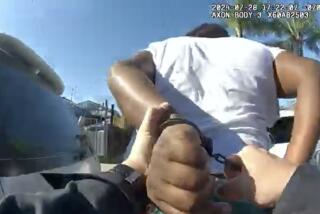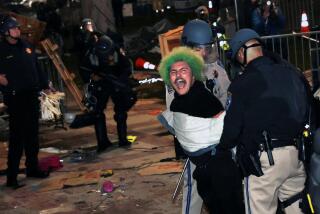Some Police Call Device a Humane Tool
- Share via
While Los Angeles police are giving up their use of pincer-style martial arts nunchakus to arrest demonstrators at anti-abortion rallies, officials of other departments say they plan to continue using the devices in routine police work as a “more humanitarian” way of dealing with potentially violent suspects.
Kevin Orcutt, the nation’s chief proponent of nunchakus, said Tuesday that he had hoped another, more recent controversy surrounding Los Angeles police--its beating with conventional batons of motorist Rodney G. King--would promote more use of the device.
Instead, Los Angeles officials said concern over the public’s growing sensitivity to excessive force spurred the department to reconsider its use of the device.
Officials in other departments say that they have had great success in using the instruments in patrol duties.
Orcutt, a Colorado police sergeant who sells nunchakus to police agencies across the country, said about 75 departments in 14 states have bought more than 10,000 of the $50 tools. A third of the departments are in California, he said.
Police officials in other departments speculated that the Los Angeles Police Department’s use of the martial arts device solely on passive anti-abortion demonstrators made them harder to sell from a public relations standpoint.
By comparison, they noted, an officer using nunchakus on an unruly drunk motorist might be seen as exercising restraint.
“A baton is more of a straight impact weapon and when you think impact, you think injury,” said San Diego Police Sgt. Chris Ellis, who directs his department’s training program. The department equips all officers with the device.
The Anaheim Police Department gives its officers the option of using nunchakus or a baton. So far, 105 of the department’s 350 officers have gone through a 16-hour training course in use of nunchakus, Lt. Ray Welch said.
“The nice thing about this is it’s a very low-profile device . . . in contrast to the baton, which is historically looked on by the public as an offensive weapon,” he said.
Also, there is a practical advantage--nunchakus are hooked to an officer’s belt, while batons often are left behind in patrol cars, Welch said.
While other departments have made nunchakus a standard part of officers’ gear, primarily to subdue potentially violent suspects, Los Angeles police limited its use of the device. In 1989, it ordered 130 to use during a series of demonstrations by Operation Rescue, whose members blocked entrances to abortion clinics and refused to move.
“Conventional compliance holds were not effective,” Los Angeles Police Sgt. Fred Nichols said. Nichols trained members of the department’s specialized Metro Unit, which handles civil disturbances, to use the nunchakus.
“I liked the tool,” he said. “We were able to walk up to a suspect who has the potential to be very combative . . . and apply it on his wrist and arm and get him to comply, because it works. It hurts. . . . You don’t have to hit him.”
While the nunchakus’ two sticks, which are connected by four inches of nylon cord, can be used much like a baton, Los Angeles officers “were not taught to use them in a striking technique,” he said, only for “compliance.”
Orcutt, whose own small department in Thornton, Colo., bought the device, said a three-month study in San Diego found that 40 officers made 323 uses of what he calls the OPN, “Orcutt Police Nunchakus.”
Of those, “they only used it 12 times to strike people,” he said. “All the others were arrest control.”
Some police officials see the exotic tool as little different than other devices that occasionally must serve as weapons.
“The use of any intervention device periodically breeds controversy,” said San Diego Sheriff Jim Roache, whose department does not use nunchakus.
“Periodically, you’ll hear of incidents where someone has been subdued and has a heart attack. . . . Nunchaku, because it’s a martial arts implement, it’s essentially an item which can be used to strike blows. . . . It appears to the uninformed and untrained eye to be harsh and abrasive.”
How Nunchakus Are Used
Nunchaku s -- a martial arts device used by about 75 police departments throughout the country--consist of two foot-long lengths of hard plastic connected by four inches of nylon cord. Although they can serve as a club, much like a conventional police baton, they most often are used to force compliance less violently. An officer wraps the device around a person’s wrist or ankle, then applies leverage on the two sticks, causing pain.
More to Read
Sign up for Essential California
The most important California stories and recommendations in your inbox every morning.
You may occasionally receive promotional content from the Los Angeles Times.









